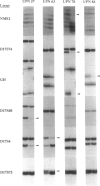Abstract
Linkage analysis in familial breast and ovarian cancer and studies of allelic deletion in sporadic ovarian tumors have identified a region on chromosome 17q containing a candidate tumor-suppressor gene (referred to as BRCA1) of likely importance in ovarian carcinogenesis. We have examined normal and tumor DNA samples from 32 patients with sporadic and 8 patients with familial forms of the disease, for loss of heterozygosity (LOH) at 21 loci on chromosome 17 (7 on 17p and 14 on 17q). LOH on 17p was 55% (22/40) for informative 17pl3.1 and 17pl3.3 markers. When six polymorphic markers flanking the familial breast/ovarian cancer susceptibility locus on 17ql2-q21 were used, LOH was 58% (23/40), with one tumor showing telomeric retention. Evaluation of a set of markers positioned telomeric to BRCA1 resulted in the highest degree of LOH, 73% (29/40), indicating that a candidate locus involved in ovarian cancer may reside distal to BRCA1. Five of the tumors demonstrating allelic loss for 17q markers were from individuals with a strong family history of breast and ovarian cancer. More important, two of these tumors (unique patient number [UPN] 57 and UPN 79) retained heterozygosity for all informative markers spanning the BRCA1 locus but showed LOH at loci distal to but not including the anonymous markers CMM86 (D17S74) and 42D6 (D17S588), respectively. Deletion mapping of seven cases (two familial and five sporadic) showing limited LOH on 17q revealed a common region of deletion, distal to GH and proximal to D17S4, that spans −25 cM. These results suggest that a potential tumor-suppressor gene involved in both sporadic and familial ovarian cancer may reside on the distal portion of chromosome 17q and is distinct from the BRCA1 gene.
Full text
PDF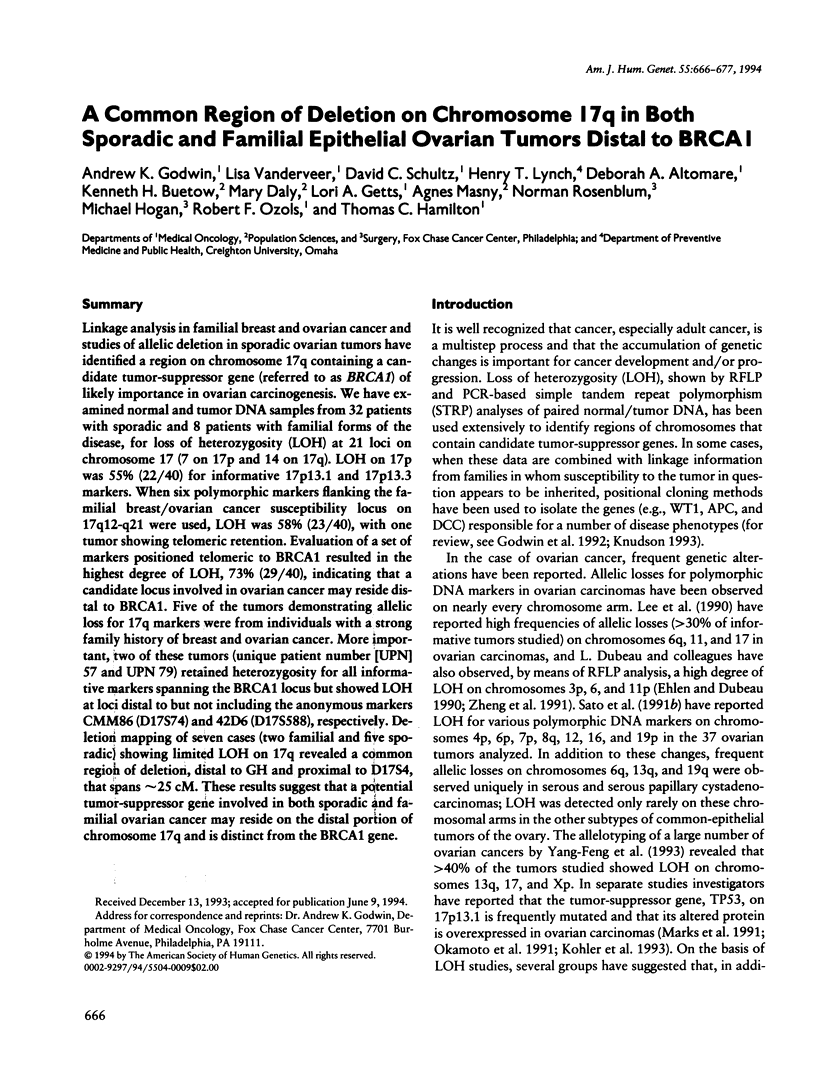

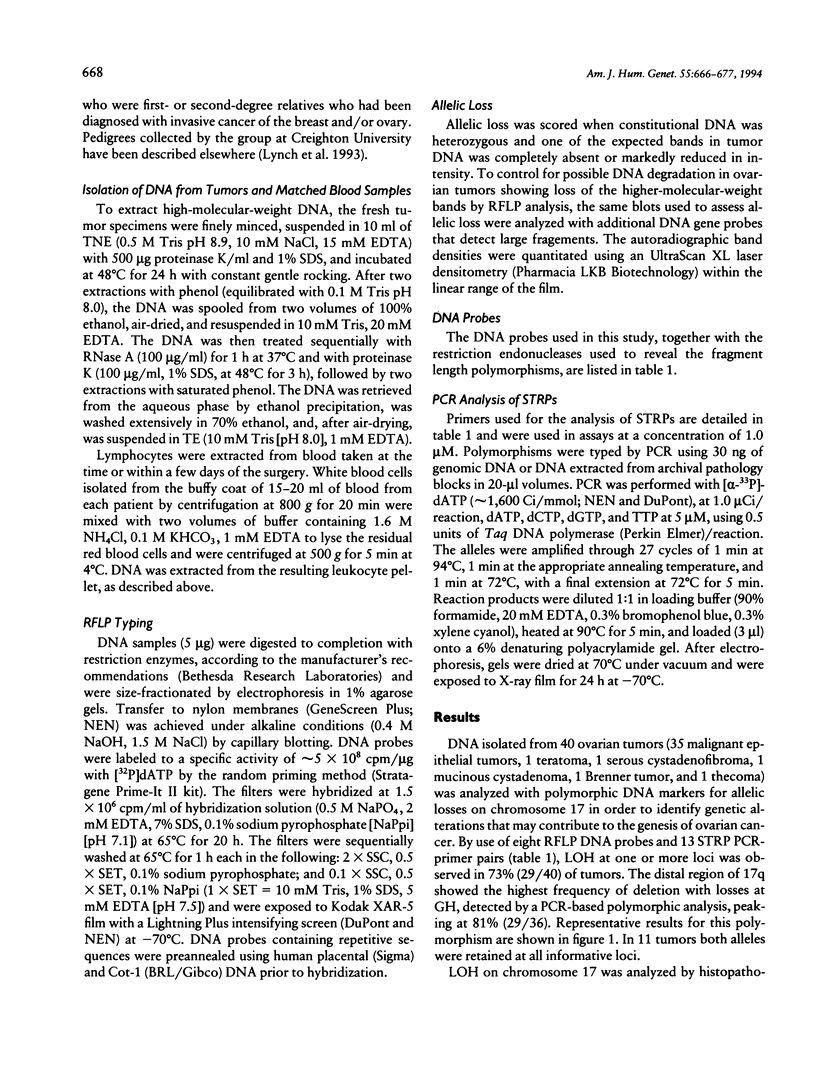
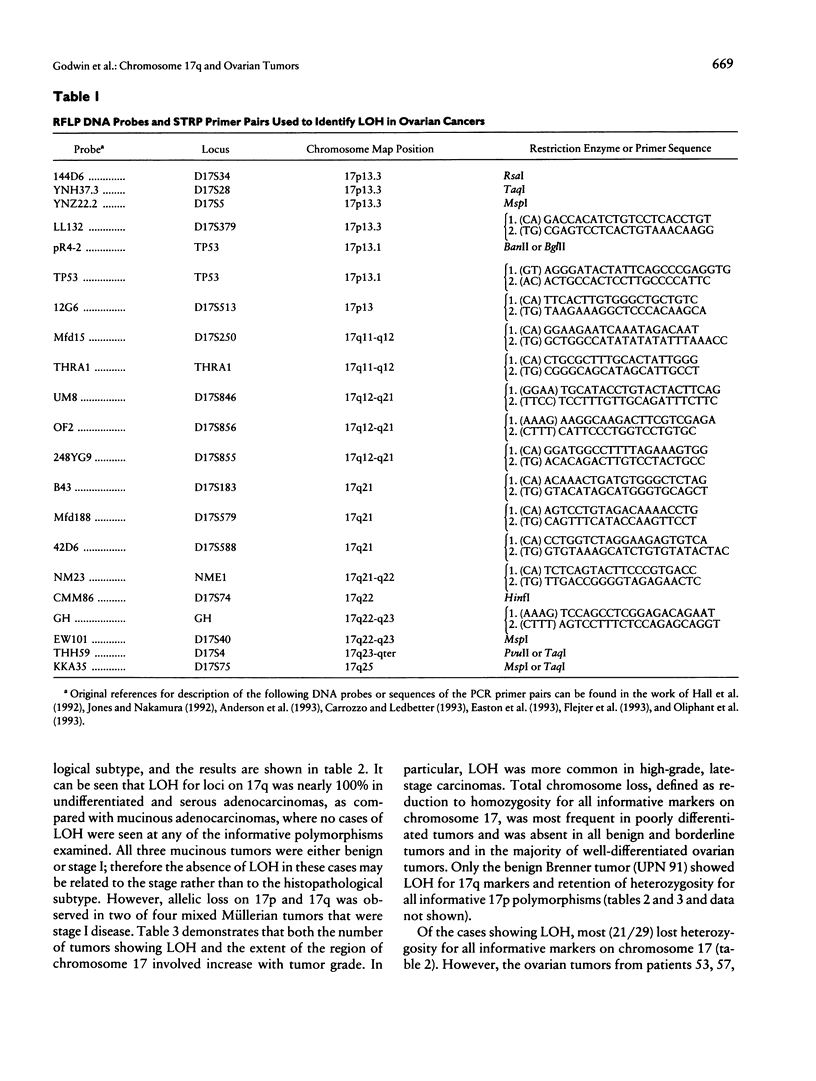
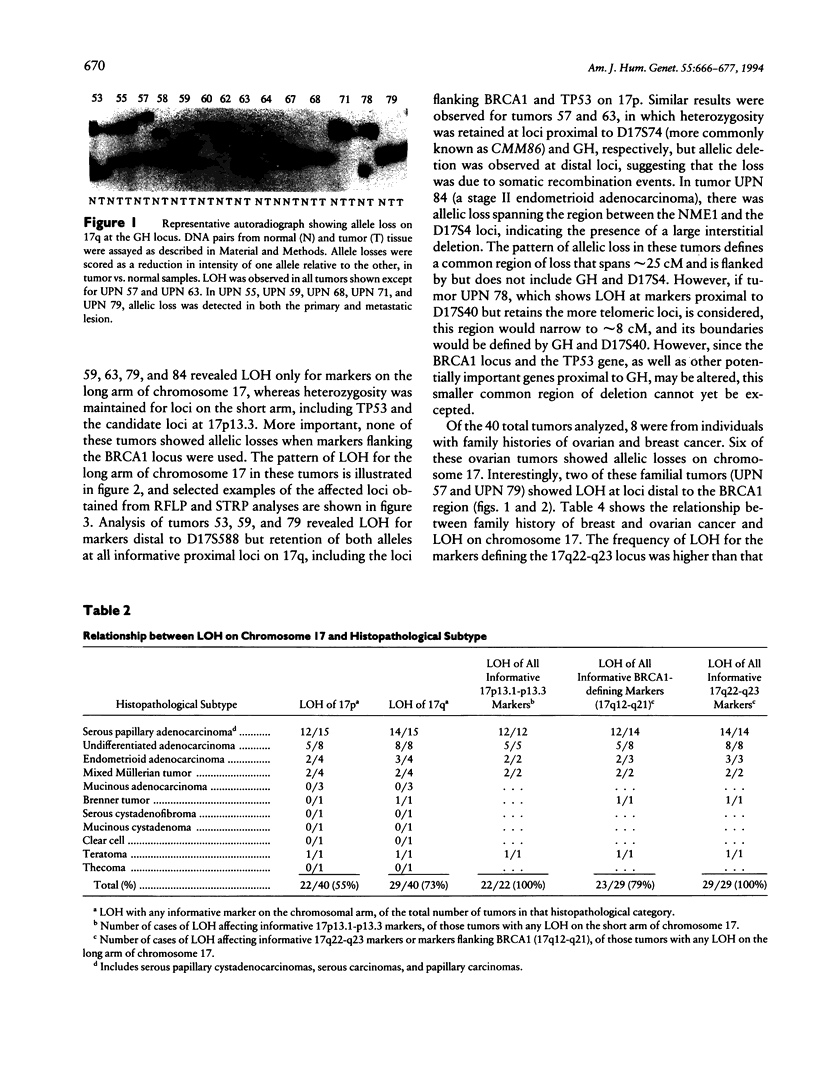
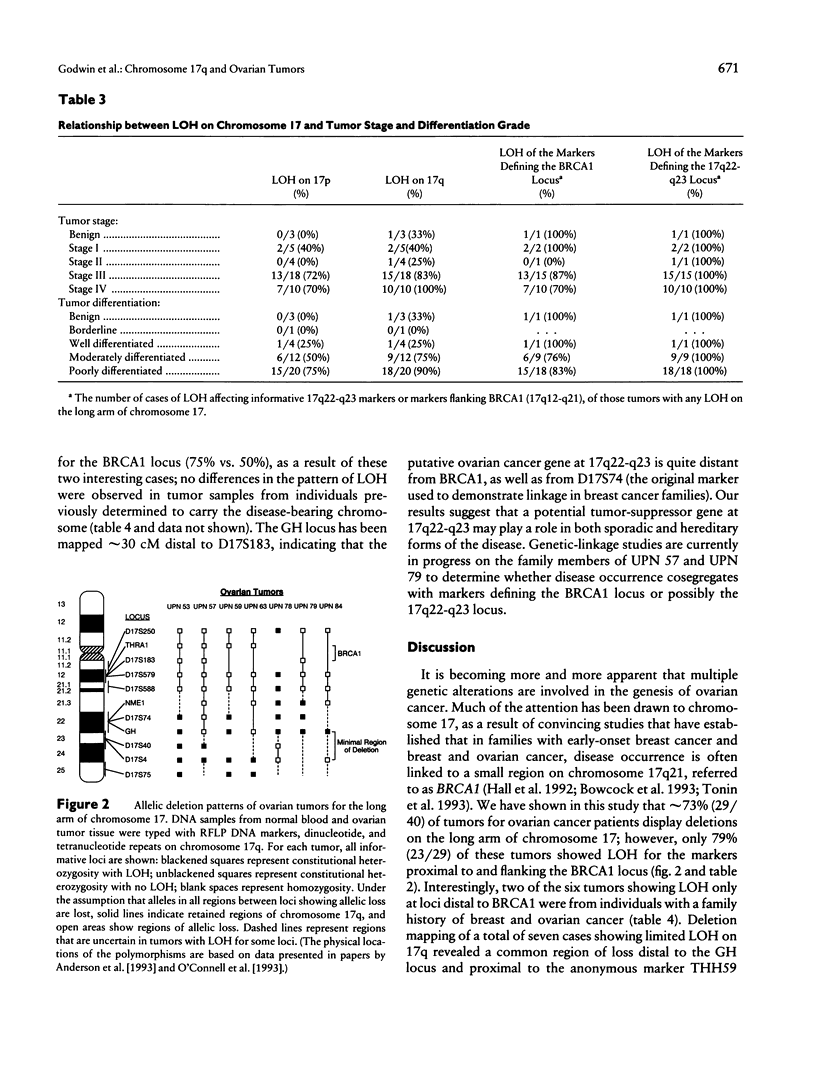
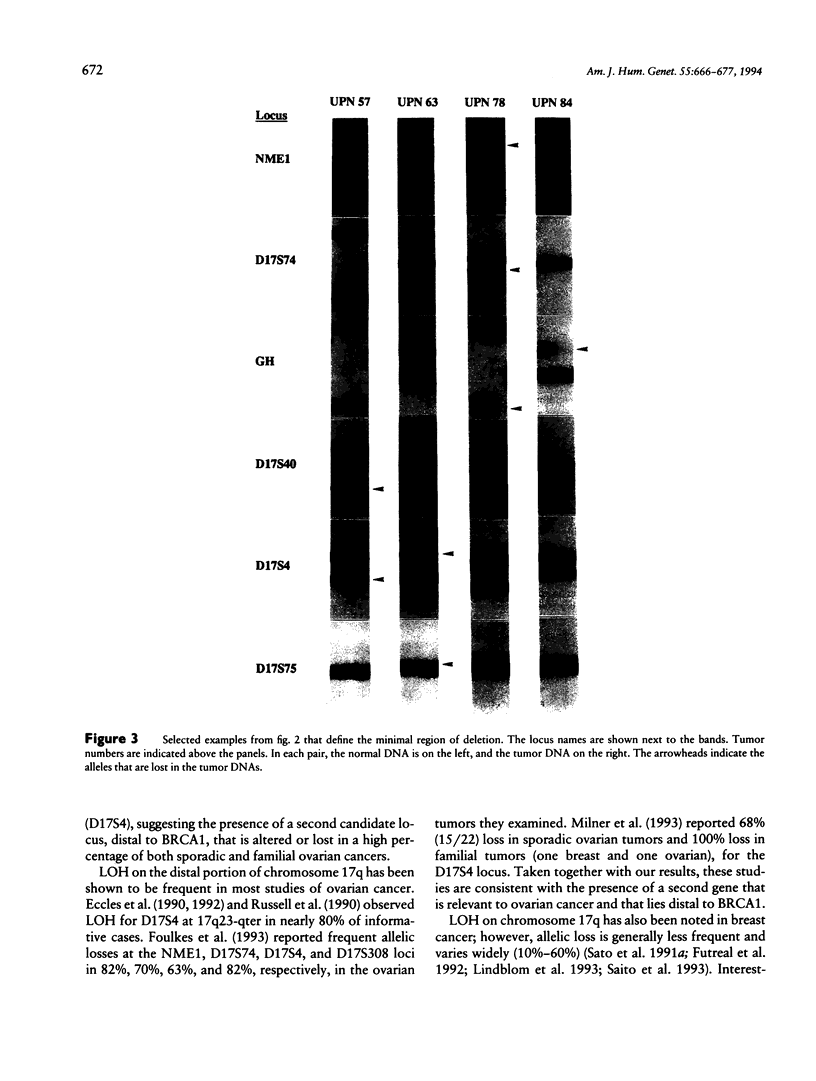
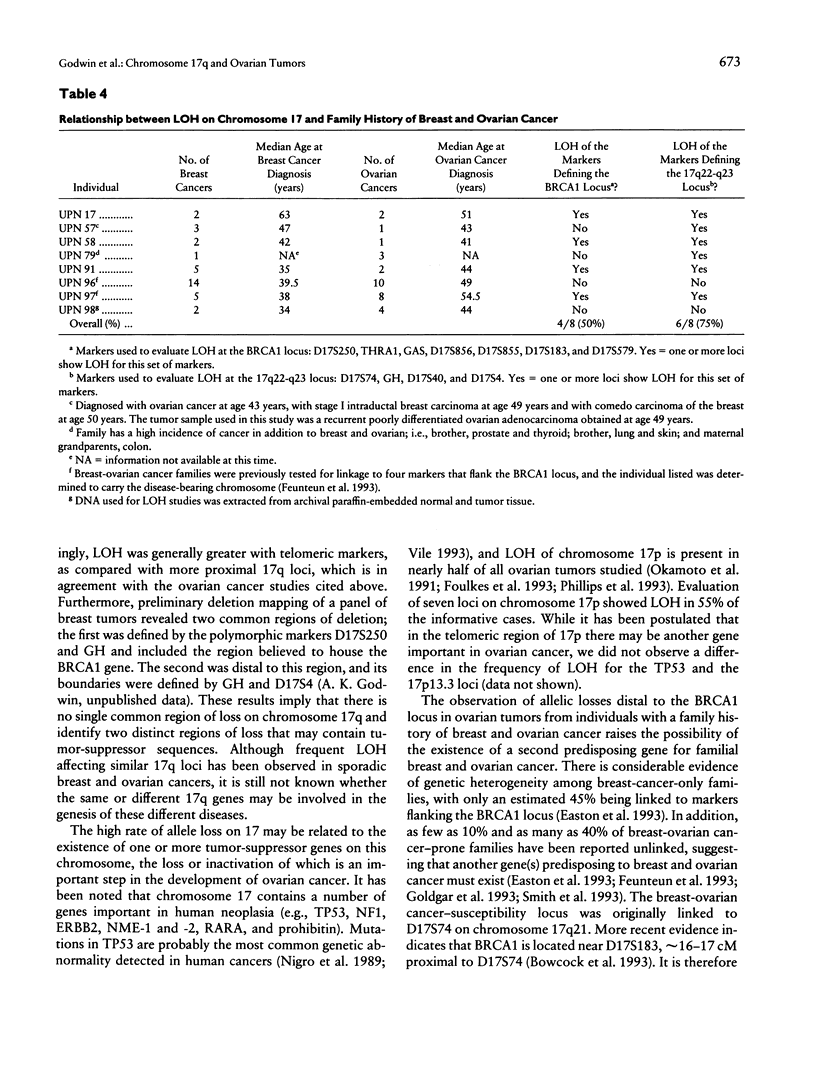
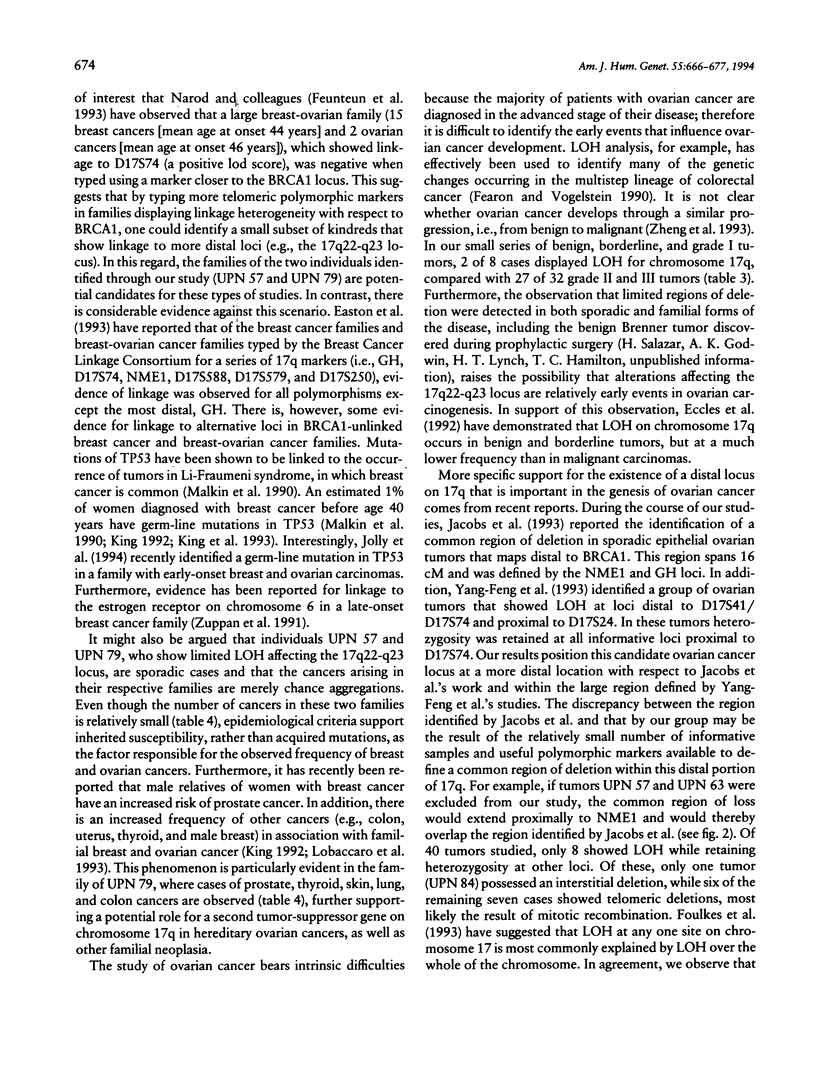
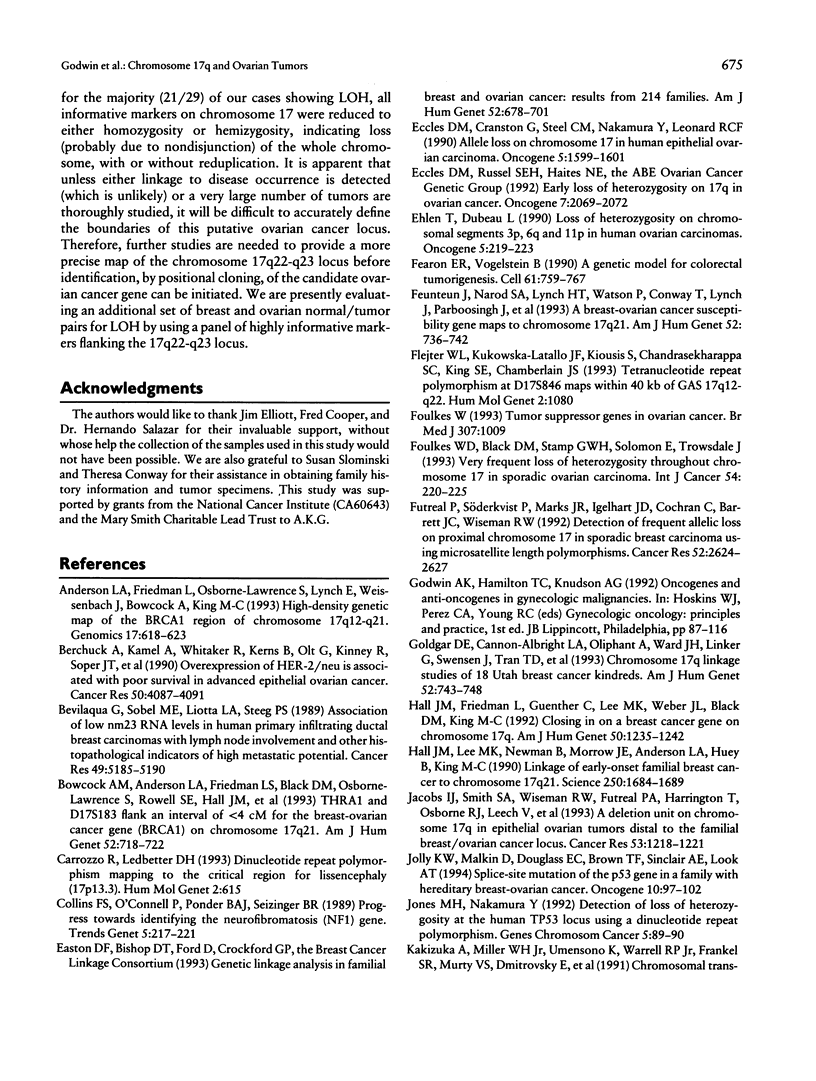
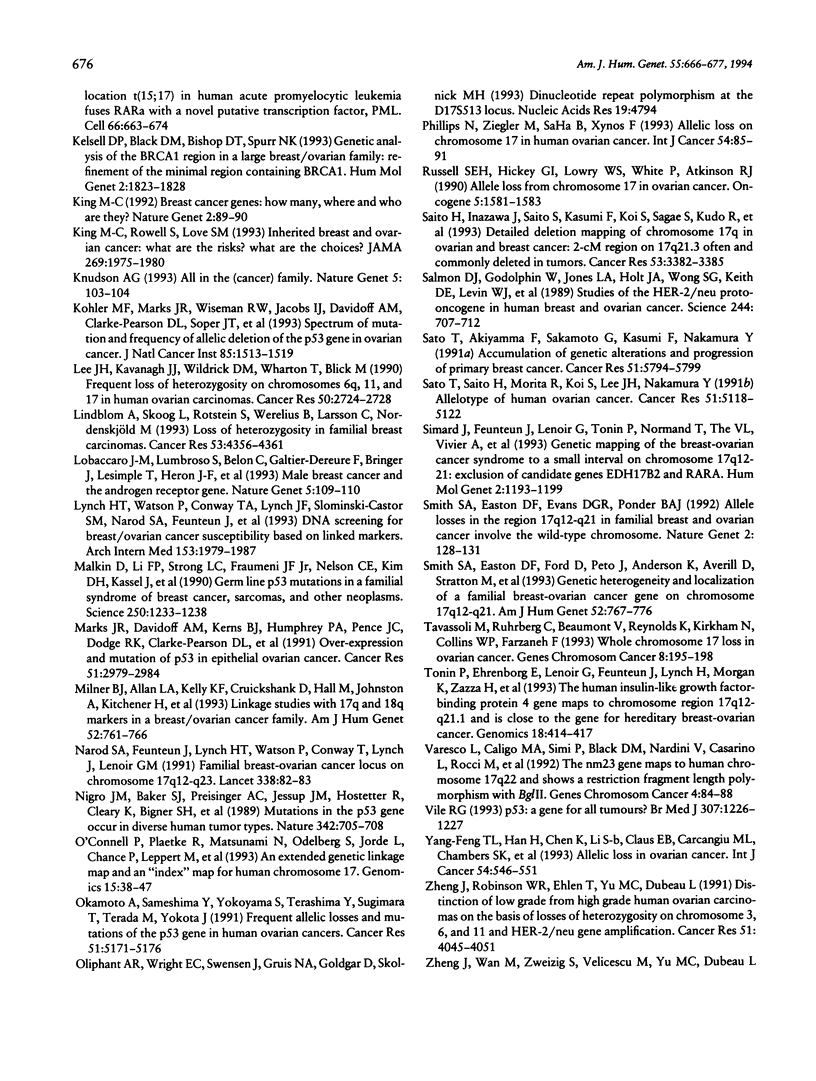

Images in this article
Selected References
These references are in PubMed. This may not be the complete list of references from this article.
- Anderson L. A., Friedman L., Osborne-Lawrence S., Lynch E., Weissenbach J., Bowcock A., King M. C. High-density genetic map of the BRCA1 region of chromosome 17q12-q21. Genomics. 1993 Sep;17(3):618–623. doi: 10.1006/geno.1993.1381. [DOI] [PubMed] [Google Scholar]
- Berchuck A., Kamel A., Whitaker R., Kerns B., Olt G., Kinney R., Soper J. T., Dodge R., Clarke-Pearson D. L., Marks P. Overexpression of HER-2/neu is associated with poor survival in advanced epithelial ovarian cancer. Cancer Res. 1990 Jul 1;50(13):4087–4091. [PubMed] [Google Scholar]
- Bevilacqua G., Sobel M. E., Liotta L. A., Steeg P. S. Association of low nm23 RNA levels in human primary infiltrating ductal breast carcinomas with lymph node involvement and other histopathological indicators of high metastatic potential. Cancer Res. 1989 Sep 15;49(18):5185–5190. [PubMed] [Google Scholar]
- Bowcock A. M., Anderson L. A., Friedman L. S., Black D. M., Osborne-Lawrence S., Rowell S. E., Hall J. M., Solomon E., King M. C. THRA1 and D17S183 flank an interval of < 4 cM for the breast-ovarian cancer gene (BRCA1) on chromosome 17q21. Am J Hum Genet. 1993 Apr;52(4):718–722. [PMC free article] [PubMed] [Google Scholar]
- Carrozzo R., Ledbetter D. H. Dinucleotide repeat polymorphism mapping to the critical region for lissencephaly (17p13.3). Hum Mol Genet. 1993 May;2(5):615–615. doi: 10.1093/hmg/2.5.615. [DOI] [PubMed] [Google Scholar]
- Collins F. S., O'Connell P., Ponder B. A., Seizinger B. R. Progress towards identifying the neurofibromatosis (NF1) gene. Trends Genet. 1989 Jul;5(7):217–221. doi: 10.1016/0168-9525(89)90085-1. [DOI] [PubMed] [Google Scholar]
- Easton D. F., Bishop D. T., Ford D., Crockford G. P. Genetic linkage analysis in familial breast and ovarian cancer: results from 214 families. The Breast Cancer Linkage Consortium. Am J Hum Genet. 1993 Apr;52(4):678–701. [PMC free article] [PubMed] [Google Scholar]
- Eccles D. M., Cranston G., Steel C. M., Nakamura Y., Leonard R. C. Allele losses on chromosome 17 in human epithelial ovarian carcinoma. Oncogene. 1990 Oct;5(10):1599–1601. [PubMed] [Google Scholar]
- Eccles D. M., Russell S. E., Haites N. E., Atkinson R., Bell D. W., Gruber L., Hickey I., Kelly K., Kitchener H., Leonard R. Early loss of heterozygosity on 17q in ovarian cancer. The Abe Ovarian Cancer Genetics Group. Oncogene. 1992 Oct;7(10):2069–2072. [PubMed] [Google Scholar]
- Ehlen T., Dubeau L. Loss of heterozygosity on chromosomal segments 3p, 6q and 11p in human ovarian carcinomas. Oncogene. 1990 Feb;5(2):219–223. [PubMed] [Google Scholar]
- Fearon E. R., Vogelstein B. A genetic model for colorectal tumorigenesis. Cell. 1990 Jun 1;61(5):759–767. doi: 10.1016/0092-8674(90)90186-i. [DOI] [PubMed] [Google Scholar]
- Feunteun J., Narod S. A., Lynch H. T., Watson P., Conway T., Lynch J., Parboosingh J., O'Connell P., White R., Lenoir G. M. A breast-ovarian cancer susceptibility gene maps to chromosome 17q21. Am J Hum Genet. 1993 Apr;52(4):736–742. [PMC free article] [PubMed] [Google Scholar]
- Flejter W. L., Kukowska-Latallo J. F., Kiousis S., Chandrasekharappa S. C., King S. E., Chamberlain J. S. Tetranucleotide repeat polymorphism at D17S846 maps within 40 kb of GAS at 17q12-q22. Hum Mol Genet. 1993 Jul;2(7):1080–1080. doi: 10.1093/hmg/2.7.1080. [DOI] [PubMed] [Google Scholar]
- Foulkes W. D., Black D. M., Stamp G. W., Solomon E., Trowsdale J. Very frequent loss of heterozygosity throughout chromosome 17 in sporadic ovarian carcinoma. Int J Cancer. 1993 May 8;54(2):220–225. doi: 10.1002/ijc.2910540210. [DOI] [PubMed] [Google Scholar]
- Foulkes W. Tumour suppressor genes in ovarian cancer. BMJ. 1993 Oct 16;307(6910):1009–1009. doi: 10.1136/bmj.307.6910.1009-b. [DOI] [PMC free article] [PubMed] [Google Scholar]
- Futreal P. A., Söderkvist P., Marks J. R., Iglehart J. D., Cochran C., Barrett J. C., Wiseman R. W. Detection of frequent allelic loss on proximal chromosome 17q in sporadic breast carcinoma using microsatellite length polymorphisms. Cancer Res. 1992 May 1;52(9):2624–2627. [PubMed] [Google Scholar]
- Goldgar D. E., Cannon-Albright L. A., Oliphant A., Ward J. H., Linker G., Swensen J., Tran T. D., Fields P., Uharriet P., Skolnick M. H. Chromosome 17q linkage studies of 18 Utah breast cancer kindreds. Am J Hum Genet. 1993 Apr;52(4):743–748. [PMC free article] [PubMed] [Google Scholar]
- Hall J. M., Friedman L., Guenther C., Lee M. K., Weber J. L., Black D. M., King M. C. Closing in on a breast cancer gene on chromosome 17q. Am J Hum Genet. 1992 Jun;50(6):1235–1242. [PMC free article] [PubMed] [Google Scholar]
- Hall J. M., Lee M. K., Newman B., Morrow J. E., Anderson L. A., Huey B., King M. C. Linkage of early-onset familial breast cancer to chromosome 17q21. Science. 1990 Dec 21;250(4988):1684–1689. doi: 10.1126/science.2270482. [DOI] [PubMed] [Google Scholar]
- Jacobs I. J., Smith S. A., Wiseman R. W., Futreal P. A., Harrington T., Osborne R. J., Leech V., Molyneux A., Berchuck A., Ponder B. A. A deletion unit on chromosome 17q in epithelial ovarian tumors distal to the familial breast/ovarian cancer locus. Cancer Res. 1993 Mar 15;53(6):1218–1221. [PubMed] [Google Scholar]
- Jolly K. W., Malkin D., Douglass E. C., Brown T. F., Sinclair A. E., Look A. T. Splice-site mutation of the p53 gene in a family with hereditary breast-ovarian cancer. Oncogene. 1994 Jan;9(1):97–102. [PubMed] [Google Scholar]
- Jones M. H., Nakamura Y. Detection of loss of heterozygosity at the human TP53 locus using a dinucleotide repeat polymorphism. Genes Chromosomes Cancer. 1992 Jul;5(1):89–90. doi: 10.1002/gcc.2870050113. [DOI] [PubMed] [Google Scholar]
- Kelsell D. P., Black D. M., Bishop D. T., Spurr N. K. Genetic analysis of the BRCA1 region in a large breast/ovarian family: refinement of the minimal region containing BRCA1. Hum Mol Genet. 1993 Nov;2(11):1823–1828. doi: 10.1093/hmg/2.11.1823. [DOI] [PubMed] [Google Scholar]
- King M. C. Breast cancer genes: how many, where and who are they? Nat Genet. 1992 Oct;2(2):89–90. doi: 10.1038/ng1092-89. [DOI] [PubMed] [Google Scholar]
- King M. C., Rowell S., Love S. M. Inherited breast and ovarian cancer. What are the risks? What are the choices? JAMA. 1993 Apr 21;269(15):1975–1980. [PubMed] [Google Scholar]
- Knudson A. G. All in the (cancer) family. Nat Genet. 1993 Oct;5(2):103–104. doi: 10.1038/ng1093-103. [DOI] [PubMed] [Google Scholar]
- Kohler M. F., Marks J. R., Wiseman R. W., Jacobs I. J., Davidoff A. M., Clarke-Pearson D. L., Soper J. T., Bast R. C., Jr, Berchuck A. Spectrum of mutation and frequency of allelic deletion of the p53 gene in ovarian cancer. J Natl Cancer Inst. 1993 Sep 15;85(18):1513–1519. doi: 10.1093/jnci/85.18.1513. [DOI] [PubMed] [Google Scholar]
- Lee J. H., Kavanagh J. J., Wildrick D. M., Wharton J. T., Blick M. Frequent loss of heterozygosity on chromosomes 6q, 11, and 17 in human ovarian carcinomas. Cancer Res. 1990 May 1;50(9):2724–2728. [PubMed] [Google Scholar]
- Lindblom A., Skoog L., Rotstein S., Werelius B., Larsson C., Nordenskjöld M. Loss of heterozygosity in familial breast carcinomas. Cancer Res. 1993 Sep 15;53(18):4356–4361. [PubMed] [Google Scholar]
- Lobaccaro J. M., Lumbroso S., Belon C., Galtier-Dereure F., Bringer J., Lesimple T., Heron J. F., Pujol H., Sultan C. Male breast cancer and the androgen receptor gene. Nat Genet. 1993 Oct;5(2):109–110. doi: 10.1038/ng1093-109. [DOI] [PubMed] [Google Scholar]
- Lynch H. T., Watson P., Conway T. A., Lynch J. F., Slominski-Caster S. M., Narod S. A., Feunteun J., Lenoir G. DNA screening for breast/ovarian cancer susceptibility based on linked markers. A family study. Arch Intern Med. 1993 Sep 13;153(17):1979–1987. [PubMed] [Google Scholar]
- Malkin D., Li F. P., Strong L. C., Fraumeni J. F., Jr, Nelson C. E., Kim D. H., Kassel J., Gryka M. A., Bischoff F. Z., Tainsky M. A. Germ line p53 mutations in a familial syndrome of breast cancer, sarcomas, and other neoplasms. Science. 1990 Nov 30;250(4985):1233–1238. doi: 10.1126/science.1978757. [DOI] [PubMed] [Google Scholar]
- Marks J. R., Davidoff A. M., Kerns B. J., Humphrey P. A., Pence J. C., Dodge R. K., Clarke-Pearson D. L., Iglehart J. D., Bast R. C., Jr, Berchuck A. Overexpression and mutation of p53 in epithelial ovarian cancer. Cancer Res. 1991 Jun 1;51(11):2979–2984. [PubMed] [Google Scholar]
- Milner B. J., Allan L. A., Kelly K. F., Cruickshank D., Hall M., Johnston A., Kitchener H., Parkin D., Haites N. Linkage studies with 17q and 18q markers in a breast/ovarian cancer family. Am J Hum Genet. 1993 Apr;52(4):761–766. [PMC free article] [PubMed] [Google Scholar]
- Narod S. A., Feunteun J., Lynch H. T., Watson P., Conway T., Lynch J., Lenoir G. M. Familial breast-ovarian cancer locus on chromosome 17q12-q23. Lancet. 1991 Jul 13;338(8759):82–83. doi: 10.1016/0140-6736(91)90076-2. [DOI] [PubMed] [Google Scholar]
- Nigro J. M., Baker S. J., Preisinger A. C., Jessup J. M., Hostetter R., Cleary K., Bigner S. H., Davidson N., Baylin S., Devilee P. Mutations in the p53 gene occur in diverse human tumour types. Nature. 1989 Dec 7;342(6250):705–708. doi: 10.1038/342705a0. [DOI] [PubMed] [Google Scholar]
- O'Connell P., Plaetke R., Matsunami N., Odelberg S., Jorde L., Chance P., Leppert M., Lalouel J. M., White R. An extended genetic linkage map and an "index" map for human chromosome 17. Genomics. 1993 Jan;15(1):38–47. doi: 10.1006/geno.1993.1007. [DOI] [PubMed] [Google Scholar]
- Okamoto A., Sameshima Y., Yokoyama S., Terashima Y., Sugimura T., Terada M., Yokota J. Frequent allelic losses and mutations of the p53 gene in human ovarian cancer. Cancer Res. 1991 Oct 1;51(19):5171–5176. [PubMed] [Google Scholar]
- Oliphant A. R., Wright E. C., Swensen J., Gruis N. A., Goldgar D., Skolnick M. H. Dinucleotide repeat polymorphism at the D17S513 locus. Nucleic Acids Res. 1991 Sep 11;19(17):4794–4794. [PMC free article] [PubMed] [Google Scholar]
- Phillips N., Ziegler M., Saha B., Xynos F. Allelic loss on chromosome 17 in human ovarian cancer. Int J Cancer. 1993 Apr 22;54(1):85–91. doi: 10.1002/ijc.2910540115. [DOI] [PubMed] [Google Scholar]
- Russell S. E., Hickey G. I., Lowry W. S., White P., Atkinson R. J. Allele loss from chromosome 17 in ovarian cancer. Oncogene. 1990 Oct;5(10):1581–1583. [PubMed] [Google Scholar]
- Saito H., Inazawa J., Saito S., Kasumi F., Koi S., Sagae S., Kudo R., Saito J., Noda K., Nakamura Y. Detailed deletion mapping of chromosome 17q in ovarian and breast cancers: 2-cM region on 17q21.3 often and commonly deleted in tumors. Cancer Res. 1993 Jul 15;53(14):3382–3385. [PubMed] [Google Scholar]
- Sato T., Akiyama F., Sakamoto G., Kasumi F., Nakamura Y. Accumulation of genetic alterations and progression of primary breast cancer. Cancer Res. 1991 Nov 1;51(21):5794–5799. [PubMed] [Google Scholar]
- Sato T., Saito H., Morita R., Koi S., Lee J. H., Nakamura Y. Allelotype of human ovarian cancer. Cancer Res. 1991 Oct 1;51(19):5118–5122. [PubMed] [Google Scholar]
- Simard J., Feunteun J., Lenoir G., Tonin P., Normand T., Luu The V., Vivier A., Lasko D., Morgan K., Rouleau G. A. Genetic mapping of the breast-ovarian cancer syndrome to a small interval on chromosome 17q12-21: exclusion of candidate genes EDH17B2 and RARA. Hum Mol Genet. 1993 Aug;2(8):1193–1199. doi: 10.1093/hmg/2.8.1193. [DOI] [PubMed] [Google Scholar]
- Slamon D. J., Godolphin W., Jones L. A., Holt J. A., Wong S. G., Keith D. E., Levin W. J., Stuart S. G., Udove J., Ullrich A. Studies of the HER-2/neu proto-oncogene in human breast and ovarian cancer. Science. 1989 May 12;244(4905):707–712. doi: 10.1126/science.2470152. [DOI] [PubMed] [Google Scholar]
- Smith S. A., Easton D. F., Evans D. G., Ponder B. A. Allele losses in the region 17q12-21 in familial breast and ovarian cancer involve the wild-type chromosome. Nat Genet. 1992 Oct;2(2):128–131. doi: 10.1038/ng1092-128. [DOI] [PubMed] [Google Scholar]
- Smith S. A., Easton D. F., Ford D., Peto J., Anderson K., Averill D., Stratton M., Ponder M., Pye C., Ponder B. A. Genetic heterogeneity and localization of a familial breast-ovarian cancer gene on chromosome 17q12-q21. Am J Hum Genet. 1993 Apr;52(4):767–776. [PMC free article] [PubMed] [Google Scholar]
- Tavassoli M., Ruhrberg C., Beaumont V., Reynolds K., Kirkham N., Collins W. P., Farzaneh F. Whole chromosome 17 loss in ovarian cancer. Genes Chromosomes Cancer. 1993 Nov;8(3):195–198. doi: 10.1002/gcc.2870080310. [DOI] [PubMed] [Google Scholar]
- Tonin P., Ehrenborg E., Lenoir G., Feunteun J., Lynch H., Morgan K., Zazzi H., Vivier A., Pollak M., Huynh H. The human insulin-like growth factor-binding protein 4 gene maps to chromosome region 17q12-q21.1 and is close to the gene for hereditary breast-ovarian cancer. Genomics. 1993 Nov;18(2):414–417. doi: 10.1006/geno.1993.1487. [DOI] [PubMed] [Google Scholar]
- Varesco L., Caligo M. A., Simi P., Black D. M., Nardini V., Casarino L., Rocchi M., Ferrara G., Solomon E., Bevilacqua G. The NM23 gene maps to human chromosome band 17q22 and shows a restriction fragment length polymorphism with BglII. Genes Chromosomes Cancer. 1992 Jan;4(1):84–88. doi: 10.1002/gcc.2870040113. [DOI] [PubMed] [Google Scholar]
- Vile R. G. p53: a gene for all tumours? BMJ. 1993 Nov 13;307(6914):1226–1227. doi: 10.1136/bmj.307.6914.1226. [DOI] [PMC free article] [PubMed] [Google Scholar]
- Yang-Feng T. L., Han H., Chen K. C., Li S. B., Claus E. B., Carcangiu M. L., Chambers S. K., Chambers J. T., Schwartz P. E. Allelic loss in ovarian cancer. Int J Cancer. 1993 Jun 19;54(4):546–551. doi: 10.1002/ijc.2910540405. [DOI] [PubMed] [Google Scholar]
- Zheng J. P., Robinson W. R., Ehlen T., Yu M. C., Dubeau L. Distinction of low grade from high grade human ovarian carcinomas on the basis of losses of heterozygosity on chromosomes 3, 6, and 11 and HER-2/neu gene amplification. Cancer Res. 1991 Aug 1;51(15):4045–4051. [PubMed] [Google Scholar]
- Zheng J., Wan M., Zweizig S., Velicescu M., Yu M. C., Dubeau L. Histologically benign or low-grade malignant tumors adjacent to high-grade ovarian carcinomas contain molecular characteristics of high-grade carcinomas. Cancer Res. 1993 Sep 15;53(18):4138–4142. [PubMed] [Google Scholar]
- Zuppan P., Hall J. M., Lee M. K., Ponglikitmongkol M., King M. C. Possible linkage of the estrogen receptor gene to breast cancer in a family with late-onset disease. Am J Hum Genet. 1991 Jun;48(6):1065–1068. [PMC free article] [PubMed] [Google Scholar]




